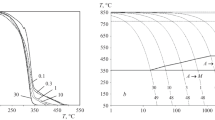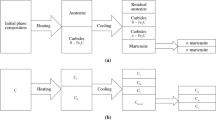The effect of quenching from the intercritical temperature range on formation of martensite-ferrite structure in steel 10Kh3G3MFS deformed preliminarily by the method of cold radial forging is considered. The microstructure of the steel is studied using optical and scanning electron microscopes. The post-quenching grain size and microhardness of the steel are determined. Tensile and impact bending tests are conducted. The dependence of the mechanical properties of the steel on the quenching mode is described. The diagrams of structural strength are used to show the possibility of formation of different combinations of strength and impact toughness by changing the heating temperature and the time of the isothermal hold in incomplete quenching.






Similar content being viewed by others

References
Yu. N. Simonov, M. Yu. Simonov, D. P. Poduzov, et al., “Transformations, structure and properties of system-alloyed low-carbon nickel-free steels,” Metal Sci. Heat Treat., 54(11–12), 558 – 564 (2013).
Yu. N. Simonov, M. Yu. Simonov, D. P. Poduzov, et al., “Transformations, structure and properties of system-alloyed low-carbon nickel-free steels,” Metalloved. Term. Obrab. Met., No. 11(689), 4 – 11 (2012).
A. N. Balakhnin, D. O. Panov, M. G. Titova, et al., “Effect of cold plastic deformation by radial forging and subsequent heat treatment on the structure and properties of steel 10Kh3G3MF,” Metalloved. Term. Obrab. Met., No. 11(689), 22 – 27 (2012).
A. S. Pertsev, D. O. Panov, Yu. N. Simonov, and A. I. Smirnov, “Formation of structure and mechanical properties of structural steel under cold plastic deformation by radial forging,” Obrab. Met. (Tekhnol., Oborud., Instrum.), No. 1, 32 – 38 (2014).
T. Barsukova, D. Panov, A. Pertsev, et al., “Evolution of structure and properties of multiphase low-carbon steel during cold radial forging,” Met. Sci. Heat Treat., 61 (2020) (DOI: https://doi.org/10.1007/s11041-020-00468-6).
M. Tokizane, N. Matsumura, K. Tsuzaki, et al., “Recrystallization and formation of austenite in deformed lath martensitic structure of low carbon steels,” Metall. Trans. A, 13, 1379 – 1388 (1982) (DOI: https://doi.org/10.1007/BF02642875).
D. O. Panov and A. I. Smirnov, “Features of austenite formation in low-carbon steel upon heating in the intercritical temperature range,” Phys. Met. Metallogr., 118(11), 1081 – 1090 (2017).
F. Manuel, C. Cerda, B. Schulz, et al., “The effect of ultrafast heating on cold-rolled low carbon steel: formation and decomposition of austenite,” Metals, 6(12), 321 (2016) (DOI: https://doi.org/10.3390/met6120321).
S. Imtiaz, A. Muhammad, and B. Muhammad, “Effect of intercritical heat treatment on mechanical properties of plain carbon dual phase steel,” Mehran Univ. Res. J. of Eng. and Technol., 37(1), 149 – 158 (2018).
L. V. Long, D. V. Hien, N. T. Thanh, et al., “Impact of cold-rolling and heat treatment on mechanical properties of dual-phase treated low carbon steel,” Adv. Mater. Sci. Eng. [open access], ID1674837 (2020) (DOI: https://doi.org/10.1155/2020/1674837).
D. Panov, T. Barsukova, A. Smirnov, et al., “Intercritical quenching of low-carbon steel with the formation of a disperse multiphase structure,” Metal Work. Mater. Sci., 4, 6– 18 (2017) (DOI: https://doi.org/10.17212/1994-6309-2017-4-6-18).
Yu. N. Simonov, M. Yu. Simonov, G. S. Shaimanov, and D. P. Poduzov, “Steel for fabricating articles with enhanced hardenability, Patent RF, MPK C 22 C 38/38,” Byull. Izobr. Polezn. Modeli, No. 31 (2014), appl. 26.03.2013, publ. 10.11.2014.
S. Q. Yuan, Z. J. Xie, J. Wang, et al., “Effect of heterogeneous microstructure on refining austenite grain size in low alloy heavy-gage plate,” Metals, 10(1), 132 (2020) (DOI: https://doi.org/10.3390/met10010132).
A. N. Makovetskii, T. I. Tabatchikova, I. L. Yakovleva, et al., “Structure formation in low-alloy pipe steel during heating in the intercritical temperature range,” Phys. Met. Metallogr., 113(7), 704 – 715 (2012) (DOI: https://doi.org/10.1134/S0031918X12070083).
T. Yu. Barsukova, D. O. Panov, and M. Yu. Simonov, “Formation of superfine-grained ferritic-martensitic structure in low-carbon structural steel under quenching from the intercritical temperature range,” Tekhnol. Met., No. 11, 2 – 12 (2019).
The study has been performed with financial support of the Ministry of Education of Russia within implementation of the program of activities of the world-level scientific and educational center “Rational Use of Mineral Resources”.
Author information
Authors and Affiliations
Corresponding author
Additional information
Translated from Metallovedenie i Termicheskaya Obrabotka Metallov, No. 7, pp. 3 – 9, July, 2021.
Rights and permissions
About this article
Cite this article
Barsukova, T.Y., Panov, D.O. & Simonov, Y.N. Laws of Formation of Structure and Properties in Cold-Deformed Low-Carbon Structural Steel Under Incomplete Quenching. Met Sci Heat Treat 63, 347–353 (2021). https://doi.org/10.1007/s11041-021-00694-6
Published:
Issue Date:
DOI: https://doi.org/10.1007/s11041-021-00694-6



